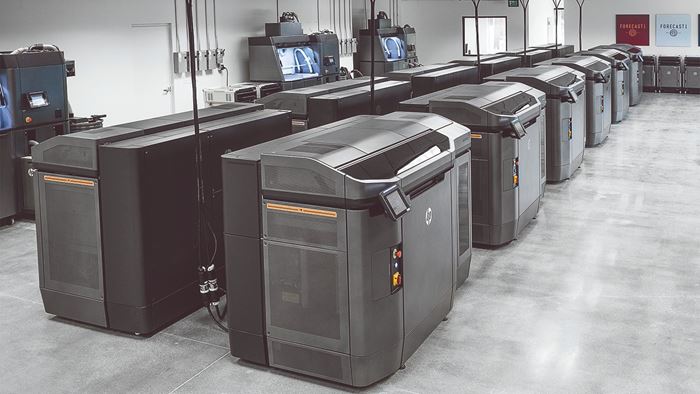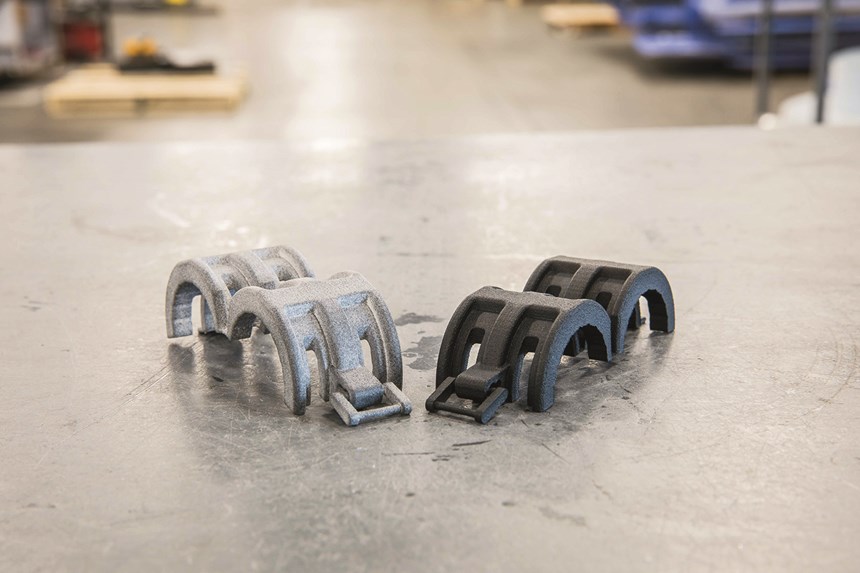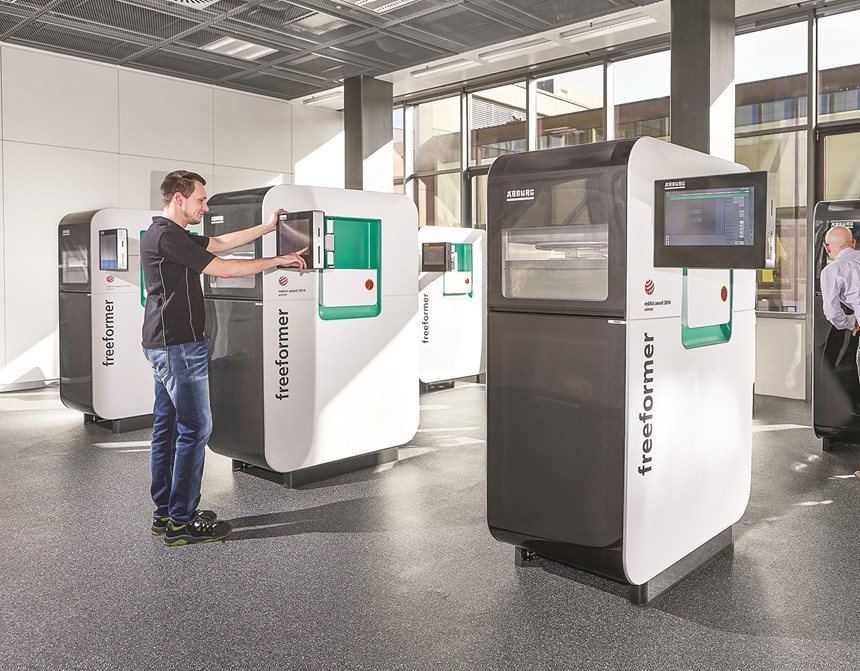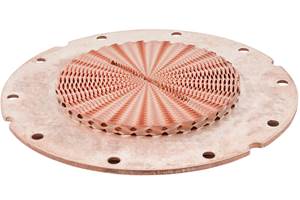Additive Manufacturing at NPE2018, from Prototyping to Production
Attending NPE2018 next week? Here's what to expect from an additive manufacturing perspective, including a new zone and workshop focused on 3D printing.
This article originally appeared on Plastics Technology’s website.
Additive manufacturing (AM)—enabled by the technology referred to as 3D printing—continues to make its mark in plastics, with more in the industry turning to the process to accelerate product development and even produce final parts. New to NPE2018 is not only a focus on 3D printing but also “4D printing.” This is where an object is 3D printed using a programmable material that enables the part to adjust its appearance or shape over time (the fourth dimension) by using internal or external stimuli, according to the business consulting firm Grand View Research, San Francisco.
Stratasys is working on this new process with MIT’s Self-Assembly Lab, which focuses on developing self-assembly technologies for large-scale structures. Their approach involves printing a multi-material composition and using the different moisture-absorbing properties of the materials to activate the self-assembly process.
The show will feature the 3D/4D Printing Zone, located in the South Hall, which will feature ways that AM technology is revolutionizing new-product creation. The zone features 30 exhibitors dedicated to the latest 3D/4D printing trends and technologies. Expect to see exhibitors representing three countries and a range of industries, from automotive to healthcare, all putting on display the wide variety of uses for AM in today’s rapidly digitizing world.
Here show attendees will see the technologies enabling many companies to produce prototypes, mold components and finished parts directly from digital files. At NPE2018, Forecast 3D will present how to use 3D printing for production manufacturing. The company claims that its AM capabilities can compete with injection molding in high-volume part production. The technology that empowers them to do this is HP’s Multi Jet Fusion 3D printers—the company has 12 of them and will be getting more soon. Its display at the show will include samples and its booth will focus on how 3D printing can be used for production.
Proto Labs, a digital manufacturer of custom prototypes and on-demand production parts, will exhibit in the 3D printing pavilion and will also display custom parts made using its quick-turn injection molding, CNC machining, and sheet-metal fabrication services.
Arburg will bring two of its Freeformer 3D printers to NPE2018, demonstrating that the system is suitable not just for prototyping, but also for manufacturing functional parts. Attendees will be able to handle parts to see their functionality and quality for themselves.
Freeformer customers can qualify their own materials for the printer and optimize the freely programmable process parameters specifically for the application at hand. The machine builder believes it is an advantage that certified original materials can be used, for example, for medical technology or the aerospace industry. In addition to amorphous standard granules such as ABS, PC and nylon 12, Arburg’s continuously expanding range of qualified materials now includes TPE, medical-grade PLLA, PC approved for the aerospace industry, and semi-crystalline PP.
On the metal side, Plustech Inc. will introduce the Sodick OPM250 metal 3D printer, which combines laser sintering of metal powder and high-speed milling in the same machine. This can speed production of tooling components, such as cores and cavities with conformal cooling channels. Additive manufacturing reportedly can produce one-piece components that would normally be assembled from multiple parts.
3D PRINTING WORKSHOP
The 3D/4D Printing Zone will feature a new 3D Printing Workshop on the afternoon of Wednesday, May 9, presented by Additive Manufacturing magazine and Plastics Technology, sister publications within Gardner Business Media. The workshop will examine everything related to 3D printing from a plastics-processing perspective.
Topics include short-run production, conformal cooling, end-of-arm tooling, bridge tooling and material advances. At press time, the scheduled sessions are:
Multi Jet Fusion vs. Traditional Mass Production Methods (1:00-1:45 PM)
Forecast 3D has been providing 3D printing services for more than 20 years and currently has 30+ printers—SLA, FDM, PolyJet, MJF and SLM. Forecast3D invested in 12 MJF systems to specifically target production, not prototyping. This presentation will be about the company’s experience in the industry and why it has invested heavily in the future of production with MJF.
Presenters: Ken Burns, technical sales director of Forecast 3D, and David Tucker, market development manager for 3D printing at HP Inc.
The Greatest Impact of AM: Conformal-Cooled Inserts (1:45-2:15 PM)
Conformal cooling achieved with metal additive manufacturing and used in injection moldmaking is where traditional manufacturing will be most impacted by additive manufacturing. To successfully execute the merger of those two disciplines takes planning and a solid process. This presentation will walk through the key elements of this process and address the challenges that arise with each step.
Presenter: Lou Young, president of Linear AMS.
New Composite Materials Make 3D-Printed Molds More Efficient and Affordable (2:15-2:45 PM)
The presenter will introduce a new class of composite materials for 3D printing of injection molds that utilize carbon nanotubes and demonstrate how it can dramatically reduce the cost of producing molds while improving performance through shorter cycle times and extended mold life. Attendees will get detailed information on how to address design, printing, post-processing and mold operations relating to 3D printed molds. Presenter: Robert Zollo, president and founder, Avante Technology LLC.
Specialized Materials for Functional Prototyping and Low Volume Production (3:15-3:45 PM)
Arburg’s freeformer can run specialized materials to create fully functional components, such as true living hinges from PP. Interfacial Consultants, a contract R&D firm that has been actively developing new materials for additive manufacturing, will share how it can create customized materials for the freeformer at low volumes. Interfacial Consultants will talk about printing PP and Ultem as well as purge compound.
Presenters: Thomas Raymond, manager of additive manufacturing, Arburg Inc.; and Philip Brunner, director of strategic accounts, Interfacial Consultants.
Influence of 3D Printing on Safety-Critical Performance Properties (3:45-4:15 PM)
UL will share its latest research findings on the impact of 3D printing on safety-critical printed part properties, such as flammability, ignition, and electrical properties that were investigated for different 3D-printing parameters.
Results were compared with conventional injection molded samples. Based on these new findings, and combined with known mechanical behavior, UL will highlight an approach for acceptance of 3D-printed materials and components in end-use products.
Presenters: Thomas Fabian, R&D manager, material science, UL; and Kenneth R. Vessey Jr., staff engineer, UL Performance Materials Division.
Related Content
3D Printing with Plastic Pellets – What You Need to Know
A few 3D printers today are capable of working directly with resin pellets for feedstock. That brings extreme flexibility in material options, but also requires greater knowledge of how to best process any given resin. Here’s how FGF machine maker JuggerBot 3D addresses both the printing technology and the process know-how.
Read MoreBeehive Industries Is Going Big on Small-Scale Engines Made Through Additive Manufacturing
Backed by decades of experience in both aviation and additive, the company is now laser-focused on a single goal: developing, proving and scaling production of engines providing 5,000 lbs of thrust or less.
Read MoreActivArmor Casts and Splints Are Shifting to Point-of-Care 3D Printing
ActivArmor offers individualized, 3D printed casts and splints for various diagnoses. The company is in the process of shifting to point-of-care printing and aims to promote positive healing outcomes and improved hygienics with customized support devices.
Read MoreWith Electrochemical Additive Manufacturing (ECAM), Cooling Technology Is Advancing by Degrees
San Diego-based Fabric8Labs is applying electroplating chemistries and DLP-style machines to 3D print cold plates for the semiconductor industry in pure copper. These complex geometries combined with the rise of liquid cooling systems promise significant improvements for thermal management.
Read MoreRead Next
Alquist 3D Looks Toward a Carbon-Sequestering Future with 3D Printed Infrastructure
The Colorado startup aims to reduce the carbon footprint of new buildings, homes and city infrastructure with robotic 3D printing and a specialized geopolymer material.
Read MoreCrushable Lattices: The Lightweight Structures That Will Protect an Interplanetary Payload
NASA uses laser powder bed fusion plus chemical etching to create the lattice forms engineered to keep Mars rocks safe during a crash landing on Earth.
Read MorePostprocessing Steps and Costs for Metal 3D Printing
When your metal part is done 3D printing, you just pull it out of the machine and start using it, right? Not exactly.
Read More
























